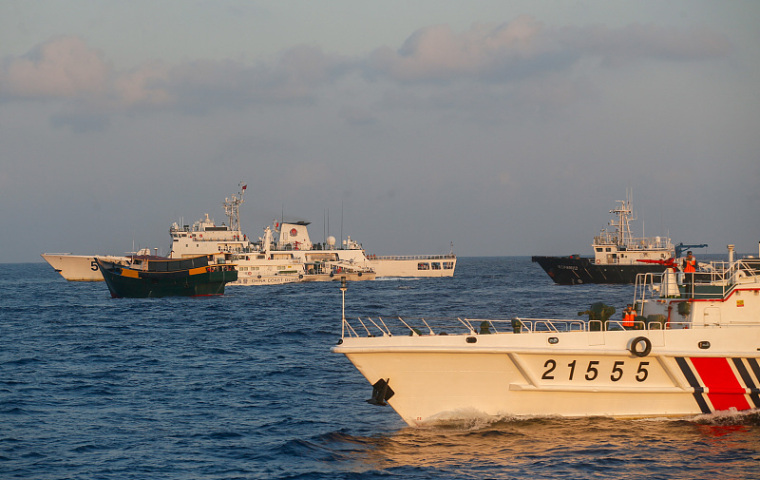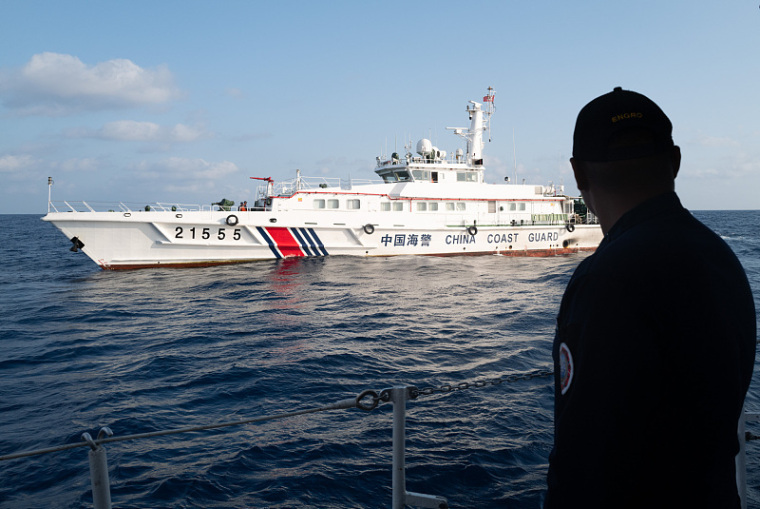China draws 'Three Red Lines' for Ren’ai Jiao
On April 11th, the spokesperson of the Chinese Ministry of Foreign Affairs explicitly drew three red lines regarding the repeated provocations by the Philippines at Ren’ai Jiao in the South China Sea.
Firstly, the prolonged presence of Philippine warships at Ren’ai Jiao constitutes a violation of Chinese sovereignty and contravenes the Declaration on the Conduct of Parties in the South China Sea, particularly Article Five which prohibits inhabitation of uninhabited islands and reefs. China demands that the Philippines immediately restore Ren’ai Jiao to its original state of being uninhabited and devoid of facilities.
Secondly, should the Philippines require provisions for the personnel inhabiting the grounded warship before it is removed from the reef, China, in a humanitarian spirit, is willing to allow the provision of supplies upon prior notification and verification by Chinese authorities, with the entire process subject to Chinese monitoring.
Thirdly, should the Philippines attempt to transport large quantities of construction materials to the reef in order to establish fixed facilities and permanent outposts, China categorically rejects this and will resolutely intercept such attempts in accordance with the law and regulations, in order to uphold Chinese sovereignty and the integrity of the Declaration on the Conduct of Parties in the South China Sea.
The delineation of these three red lines signifies China’s policy declaration. But why has China chosen this moment to delineate these red lines? And what significance and practical implications do they hold?

Philippines Contradictorily Denies Sino-Philippine Historical Accord
On April 10th, Philippine President Marcos publicly denied the “gentleman’s agreement” between China and the Philippines regarding the humanitarian resupply at Ren’ai Jiao, citing alleged damage to “territory, sovereignty, and sovereign rights.” He expressed supposed shock at the Duterte administration’s purported understanding with China. However, this stance is riddled with inaccuracies.
Recently, many former Philippine officials who were intimately involved have repeatedly confirmed a series of commitments, understandings, and appropriate arrangements between China and the Philippines over the years. In fact, the humanitarian arrangement regarding the illegally grounded warship at Ren’ai Jiao did not originate during the Duterte era. The so-called "gentleman’s agreement" between the Duterte government and China merely continues a long-standing understanding between the two nations.
In 1999, the Philippines maliciously grounded warships simultaneously at Ren’ai Jiao and Huangyan Dao. Following negotiations with China, the Philippines removed the illegally grounded warship from Huangyan Dao. Since then, China and the Philippines have made appropriate arrangements regarding the grounded warship at Ren’ai Jiao, with the Philippines committing to remove the warship and China providing suitable humanitarian resupply arrangements.
Over the past 25 years, without the mutual understanding between China and the Philippines, this dilapidated warship would not remain intact today. In 2003 and during the period from 2013 to 2015, the Philippines had planned to reinforce and expand the grounded warship, but each time, these plans were abandoned due to consensus reached through appropriate communication between China and the Philippines.
Without the appropriate arrangements between China and the Philippines, why has the dilapidated warship, grounded for 25 years, not become a permanent structure? How does the Philippine government ensure the daily life of the personnel stationed there? And why hasn’t China taken action against the warship all this time?
The fact that this illegally grounded warship has remained in its current state for 25 years is indeed evidence of the effective and continuous role played by the appropriate arrangements and “gentleman’s agreement” between China and the Philippines.
However, now, the Marcos government has torn up this agreement, repeatedly resorted to deceitful denials, and undermined the understandings reached multiple times, leading to new risks of conflict and confrontation in the vicinity of the grounded warship.
At the same time, Marcos’s disregard for the longstanding proper arrangements between China and the Philippines, and his attempt to shift the blame for the gentleman’s agreement onto Duterte, further exposes his true motive of manipulating South China Sea provocations to serve domestic political struggles.
The Marcos government claims that the issue of Ren’ai Jiao concerns territory, sovereignty, and sovereign rights. In reality, if we consider the position taken by the Philippines in unilaterally initiating the South China Sea arbitration case, wherein the Philippines acknowledged that all features in the South China Sea are low-tide elevations, then it essentially relinquished its claims to territory and sovereignty in the South China Sea, including any rights it may assert over Ren’ai Jiao by illegally grounding its vessel there.

Ren’ai Jiao: Historically and Presently Uninhabited Island Reef
Article Five of the Declaration on the Conduct of Parties in the South China Sea clearly stipulates that “the Parties undertake to exercise self-restraint in the conduct of activities that would complicate or escalate disputes and affect peace and stability, including, among others, refraining from inhabiting presently uninhabited islands, reefs, shoals, cays, and other features, and handling their differences in a constructive manner.”
The history and current status of Ren’ai Jiao both indicate it is an uninhabited feature. The presence of an illegally grounded warship does not alter the uninhabited nature of Ren’ai Jiao.
As a signatory to the Declaration on the Conduct of Parties in the South China Sea, the current Philippine authorities persist in advancing a series of measures to establish Ren’ai Jiao as a permanent military outpost based on the illegally grounded warship. These measures include but are not limited to initiating expansion projects, allocating funds for construction, continuously implementing abnormal resupply operations, and planning to discredit and defame. These actions undoubtedly violate the commitments made by the Philippines in the Declaration on the Conduct of Parties in the South China Sea and intentionally undermine the efforts made by China and ASEAN countries to promote peace and stability in the South China Sea.
Therefore, China demands that the Philippines “immediately restore Ren’ai Jiao to its original state of being uninhabited and devoid of facilities.” This demand is lawful, reasonable, and justifiable, aligning with the commitments made by all parties in the Declaration on the Conduct of Parties in the South China Sea and serving the common interests of all coastal countries in the South China Sea.
Drawing Red Lines: An Internationally Recognized Positive Step
Adhering to commitments and maintaining tacit agreements are long-standing effective means of safeguarding peace and stability in the South China Sea, a shared stance upheld by China and other ASEAN countries. In the face of the Philippine authorities’ complete abandonment of commitments and disruption of tacit agreements, as well as the repeated malicious violations of various understandings through diplomatic channels, setting red lines is a proactive measure to assert positions, stabilize the situation, and avoid miscalculations.
Clarifying red lines is a common practice among countries to avoid conflicts and miscalculations regarding international and regional hot-button issues. It is advantageous in cases where diplomatic channels fail, providing a clear signal to prevent the other party from making erroneous decisions that could lead to uncontrollable escalation of conflicts. We have witnessed the important role of this strategic measure in many major crises since the Cold War.
China’s three red lines are very clear and concise: first, demanding the immediate restoration of Ren’ai Jiao to its original state of being uninhabited and devoid of facilities; second, requiring prior notification, verification, and monitoring of humanitarian resupply operations; and third, stating that China will take strong measures against any attempts at illegal reinforcement and expansion. These three red lines demonstrate a clear stance, a strong signal, and precise actions.
A red line is a bottom line. The Marcos government should seriously heed China’s clear signals, immediately abandon any unilateral attempts to alter the status quo and exacerbate the situation at Ren’ai Jiao, and cease its repeated probing of China’s bottom line through conflict-prone policies. It should avoid any provocative actions that would lead to a decisive response.
Finally and most importantly, China’s establishment of red lines underscores its ongoing efforts to uphold the seriousness of the Declaration on the Conduct of Parties in the South China Sea. Faced with the Philippines’ continued malicious provocations at Ren’ai Jiao, China maintains a high level of restraint, employing professional and rational approaches to prevent the situation from spiraling out of control and causing a crisis beyond containment, thus safeguarding the security interests and well-being of the people in the surrounding countries of the South China Sea.
The history of the South China Sea and the basic laws of international security indicate that only through dialogue, negotiation, and consultation can true peace and stability be restored to the region, promoting development, prosperity, and sustainable security for all neighboring countries.
(Author: Yang Xiao, Deputy Director of the Institute of Maritime Strategy Studies, China Institutes of Contemporary International Relations)














